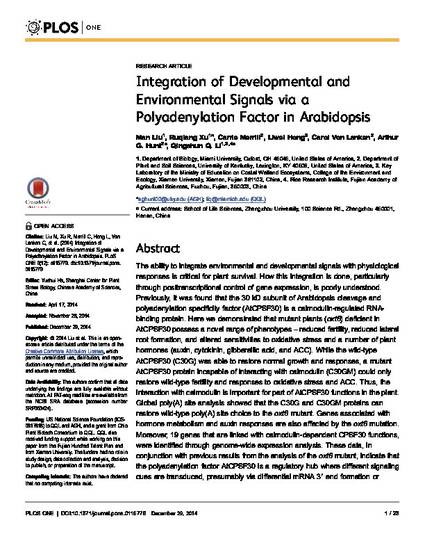
The ability to integrate environmental and developmental signals with physiological responses is critical for plant survival. How this integration is done, particularly through posttranscriptional control of gene expression, is poorly understood. Previously, it was found that the 30 kD subunit of Arabidopsis cleavage and polyadenylation specificity factor (AtCPSF30) is a calmodulin-regulated RNA-binding protein. Here we demonstrated that mutant plants (oxt6) deficient in AtCPSF30 possess a novel range of phenotypes--reduced fertility, reduced lateral root formation, and altered sensitivities to oxidative stress and a number of plant hormones (auxin, cytokinin, gibberellic acid, and ACC). While the wild-type AtCPSF30 (C30G) was able to restore normal growth and responses, a mutant AtCPSF30 protein incapable of interacting with calmodulin (C30GM) could only restore wild-type fertility and responses to oxidative stress and ACC. Thus, the interaction with calmodulin is important for part of AtCPSF30 functions in the plant. Global poly(A) site analysis showed that the C30G and C30GM proteins can restore wild-type poly(A) site choice to the oxt6 mutant. Genes associated with hormone metabolism and auxin responses are also affected by the oxt6 mutation. Moreover, 19 genes that are linked with calmodulin-dependent CPSF30 functions, were identified through genome-wide expression analysis. These data, in conjunction with previous results from the analysis of the oxt6 mutant, indicate that the polyadenylation factor AtCPSF30 is a regulatory hub where different signaling cues are transduced, presumably via differential mRNA 3' end formation or alternative polyadenylation, into specified phenotypic outcomes. Our results suggest a novel function of a polyadenylation factor in environmental and developmental signal integration.
US National Science Foundation (IOS-0817818) to QQL and AGH, and a grant from Ohio Plant Biotech Consortium to QQL. QQL also received funding support while working on this paper from the Fujian Hundred Talent Plan and from Xiamen University. The funders had no role in study design, data collection and analysis, decision to publish, or preparation of the manuscript.
Available at: http://works.bepress.com/arthur_hunt/7/
Published in PLOS One, v. 9, no. 12, article e115779, p. 1-23.
© 2014 Liu et al.
This is an open-access article distributed under the terms of the Creative Commons Attribution License, which permits unrestricted use, distribution, and reproduction in any medium, provided the original author and source are credited.